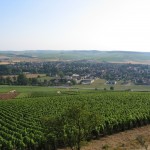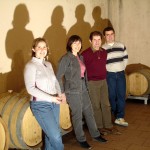Bodegas Williams & Humbert
The history of Bodegas Williams & Humbert goes back nearly 130 years. They participated in the creation of the Jerez-Xeres-Brandy Quality Demarcation and are now considered to be one of the world’s most prestigious wine producers.
The winery was founded in 1877 by Sir Alexander Williams, a great admirer and connoisseur of sherry products and Arthur Humbert, a specialist in international relations. Since then they have preserved part of the original wines and brandies (soleras) in high quality oak casks. These soleras are the base of the development and ageing of every sherry and brandy produced at Bodegas Williams & Humbert.
The following are summaries and tasting notes of many of the Sherries that Williams & Humbert are world famous for :
DRY SAC FINO SHERRY
 This is a very dry Fino Sherry produced from Palomino grapes. Bud musts from the best vineyards undergo cold, still fermentation at 22C. Then they go through early filtering and classification by quality. The best wine distillations are fortified at 15c to be racked in clean casks. They are then put into the traditional system of dynamic ageing employed in Jerez – Criaderas y Soleras- in the 6th criadera cask, where the biological ageing under a layer of yeast takes place in the traditional oak casks, preferably of American oak. The ageing is minimum five years while the wine passes from one criadera to another until it reaches the solera, from which it is drawn out for consumption.
This is a very dry Fino Sherry produced from Palomino grapes. Bud musts from the best vineyards undergo cold, still fermentation at 22C. Then they go through early filtering and classification by quality. The best wine distillations are fortified at 15c to be racked in clean casks. They are then put into the traditional system of dynamic ageing employed in Jerez – Criaderas y Soleras- in the 6th criadera cask, where the biological ageing under a layer of yeast takes place in the traditional oak casks, preferably of American oak. The ageing is minimum five years while the wine passes from one criadera to another until it reaches the solera, from which it is drawn out for consumption.
Tasting Notes : A wine of brilliant, pale gold colours. Intense, complex aromas reminiscent of the yeast layer with a hint of almond. Delicate yet full-bodied, with character and elegance. A long aftertaste and nose.
Suggestions with Food : Ideal for aperitifs accompanied by a high quality cheese, ham and seafood dishes. Also excellent with almonds.
DRY SAC MEDIUM SHERRY
 This a blended Oloroso or Medium Sherry produced from Palomino and Pedro Ximenez grapes. Bud musts undergo controlled fermentation at 28c and fortified with alcohol distilled from wine up to 19.5 degrees. Palomino and Pedro Ximenez are racked into clean casks while waiting to enter the Criaderas y Soleras system. Physical-chemical ageing through oxidation for at least six years, obtaining a slightly sweetened oloroso or medium sherry.
This a blended Oloroso or Medium Sherry produced from Palomino and Pedro Ximenez grapes. Bud musts undergo controlled fermentation at 28c and fortified with alcohol distilled from wine up to 19.5 degrees. Palomino and Pedro Ximenez are racked into clean casks while waiting to enter the Criaderas y Soleras system. Physical-chemical ageing through oxidation for at least six years, obtaining a slightly sweetened oloroso or medium sherry.
Tasting Notes: An amber-coloured wine of intense aromas suggesting dried nuts. Full bodied and balanced, with little acid and slightly sweet .
Suggestions with Food: It can be drunk neat or with ice. It is recommended as an aperitif or to accompany pasta and rice dishes.
CANASTA SHERRY
 A sweet Oloroso or Cream Sherry produced from Palomino and Pedro Ximenez grapes. The bud musts undergo controlled fermentation and fortified at 19.5 degrees. An elegant blend of Palomino and Pedro Ximenez before entering the Criaderas y Soleras system for physical-chemical ageing through oxidation in oak casks. Aged for at least six years. A unique sweet Oloroso or “Cream” Sherry.
A sweet Oloroso or Cream Sherry produced from Palomino and Pedro Ximenez grapes. The bud musts undergo controlled fermentation and fortified at 19.5 degrees. An elegant blend of Palomino and Pedro Ximenez before entering the Criaderas y Soleras system for physical-chemical ageing through oxidation in oak casks. Aged for at least six years. A unique sweet Oloroso or “Cream” Sherry.
Tasting Notes: Sweet Oloroso. Mahogany colour and aromas of dried nuts with a hint of raisins and brown sugar. Smooth, velvety palate with warm alcohol flavours and a persistent aftertaste.
Suggestions for Food : It can be consumed very cold by itself and with desserts, or on ice as a refreshing early evening drink.
WALNUT BROWN SHERRY
 This is a very Sweet Oloroso or Cream Sherry produced from Palomino, Pedro Ximenez and Muscatel grapes. Bud musts undergo controlled fermentation and fortified at 19.5 degrees. Palomino, Pedro Ximenez and Muscatel are blended and racked into clean casks before entering the Criaderas y Solera system for physical-chemical ageing through oxidation in oak casks. Aged for at least four years.
This is a very Sweet Oloroso or Cream Sherry produced from Palomino, Pedro Ximenez and Muscatel grapes. Bud musts undergo controlled fermentation and fortified at 19.5 degrees. Palomino, Pedro Ximenez and Muscatel are blended and racked into clean casks before entering the Criaderas y Solera system for physical-chemical ageing through oxidation in oak casks. Aged for at least four years.
Tasting Notes: Very sweet oloroso.Dark mahogany, almost ebony. On the nose, dried nuts and faint aroma of raisins, muscatel and toasted sugar. Smooth and velvety with a warm palate owing to its alcohol content. A long finish.
Suggestions for Food: It can be consumed very cold by itself and with desserts, or on ice as a refreshing long drink.
WINTER’S TALE SHERRY
 This a slightly sweetened Amontillado or “Medium Sweet” Sherry produced from Palomino and Pedro Ximenez grapes. The bud must undergoes controlled fermentation and fortified with alcohol distilled from wine at 28 degrees. Palomino and Pedro Ximenez are racked before entering the Criaderas y Soleras system for physical-chemical ageing through oxidation in oak casks. Aged for at least six years. A slightly sweetened oloroso, or “medium sweet” sherry.
This a slightly sweetened Amontillado or “Medium Sweet” Sherry produced from Palomino and Pedro Ximenez grapes. The bud must undergoes controlled fermentation and fortified with alcohol distilled from wine at 28 degrees. Palomino and Pedro Ximenez are racked before entering the Criaderas y Soleras system for physical-chemical ageing through oxidation in oak casks. Aged for at least six years. A slightly sweetened oloroso, or “medium sweet” sherry.
Tasting Notes: Brillant amber. Intense aroma of dried nuts. Full bodied and balanced, with low acidity. Sweet and persistent.
Suggestions for Food: To be drunk neat or on ice. Ideal as an aperitif or with pasta and rice dishes.
JALIFA AMONTILLADO 30 YEARS SHERRY
 This a dry Amontillado Sherry produced from Palomino grapes. Bud musts from the best vineyards undergo cold, still decanting and fermentation at 22c. Early filtering, classification by quality and fortified at 15 degrees with the best distilled wines to obtain the traditional racks. Put into the classical Jerez Criaderas y Soleras system of dynamic ageing at the 15th criadera, where the biological ageing takes place under a layer of yeast. Aged in traditional oak casks , preferably American for at least 8 years, after which it is transferred to the 6th criadera for an additional 22 years of natural ageing by oxidation until it reaches the solera. It is then removed for consumption.
This a dry Amontillado Sherry produced from Palomino grapes. Bud musts from the best vineyards undergo cold, still decanting and fermentation at 22c. Early filtering, classification by quality and fortified at 15 degrees with the best distilled wines to obtain the traditional racks. Put into the classical Jerez Criaderas y Soleras system of dynamic ageing at the 15th criadera, where the biological ageing takes place under a layer of yeast. Aged in traditional oak casks , preferably American for at least 8 years, after which it is transferred to the 6th criadera for an additional 22 years of natural ageing by oxidation until it reaches the solera. It is then removed for consumption.
Tasting Notes: Bright hues of very old gold and amber. Pungent, intense and complex on the nose, with a subtle note of fino sherry and a hint of dried nuts and filbert. Dry with excellent acidity, a long, full bodied and elegant palate. A delightfully expressive and unforgettable finish.
Suggestions with Food: An excellent aperitif served with a fine cheese, ham or seafood dishes.
DOS CORTADOS 20 YEARS SHERRY
 A fortified wine, this rare and peculiar dry Pale Cortado Sherry produced from Palomino grapes is halfway between an Amontillado and an Oloroso. Bud musts from the best vineyards undergo cold, still decanting and fermentation at 22c. Early filtration, classification by quality and then the must is fortified at 15degrees with the best distilled wines to obtain the traditional racks. Put into the Criaderas y Soleras system in fino sherry casks for biological ageing. Sporadically, circumstances cause the contents of some casks to behave differently than it is expected – they will not become fino sherry. These casks are “cut” (hence the term “cortado”) with one or two jugs of alcohol to form the base of the palo cortado solera system. The wine is then aged for 20 years until it reaches the solera.
A fortified wine, this rare and peculiar dry Pale Cortado Sherry produced from Palomino grapes is halfway between an Amontillado and an Oloroso. Bud musts from the best vineyards undergo cold, still decanting and fermentation at 22c. Early filtration, classification by quality and then the must is fortified at 15degrees with the best distilled wines to obtain the traditional racks. Put into the Criaderas y Soleras system in fino sherry casks for biological ageing. Sporadically, circumstances cause the contents of some casks to behave differently than it is expected – they will not become fino sherry. These casks are “cut” (hence the term “cortado”) with one or two jugs of alcohol to form the base of the palo cortado solera system. The wine is then aged for 20 years until it reaches the solera.
Tasting Notes : Bright hues of very old gold and amber . Pungent, intense and complex on the nose, with a subtle note of filberts and dried fruits. Dry with excellent acidity, a long, full-bodied and elegant palate. An incredibly expressive and unforgettable finish. Sherry with an amontillado nose and an oloroso palate.
Suggestions with Food: Excellent as an aperitif for those long evenings or in short drinks with tapas.
DRY OLOROSO 12 YEARS
 This is a dry Oloroso produced from Palomino grapes. The bud musts undergo controlled fermentation at 28c, then fortified with distilled wine alcohol at up to 19.5degrees. The Palomino enters the racks before entering the Criaderas y Soleras system for physical-chemical ageing through oxidation in oak casks. It is aged for at least 12 years. This is a unique dry Oloroso.
This is a dry Oloroso produced from Palomino grapes. The bud musts undergo controlled fermentation at 28c, then fortified with distilled wine alcohol at up to 19.5degrees. The Palomino enters the racks before entering the Criaderas y Soleras system for physical-chemical ageing through oxidation in oak casks. It is aged for at least 12 years. This is a unique dry Oloroso.
Tasting Notes: Bright amber. Intense aromas characteristic of this type of wine and a hint of dried nuts and fruits. Dry, rich, with smooth tannins, it is luscious and balanced with a long finish.
Suggestions for Food: As an aperitif with mature cheese, at meals with red meats and even as an after-dinner drink.
HAPPY WILLIAMS & HUMBERT SHERRY DAYS
DEL
 Comments Off on CHABLIS, DOMAINE MOREAU
Comments Off on CHABLIS, DOMAINE MOREAU 








